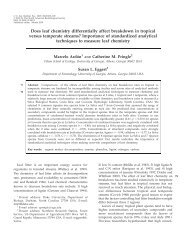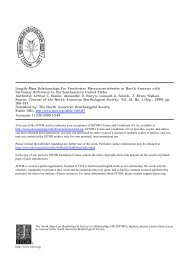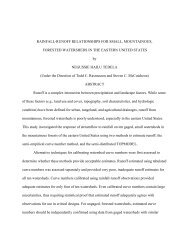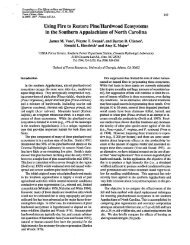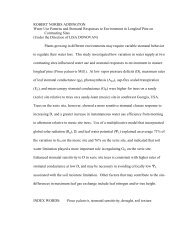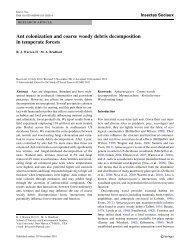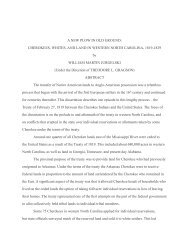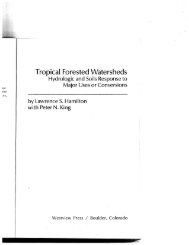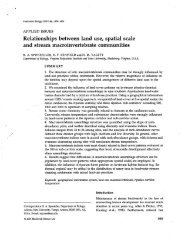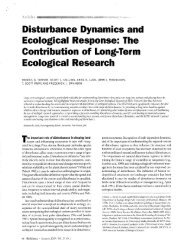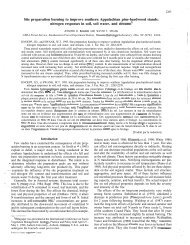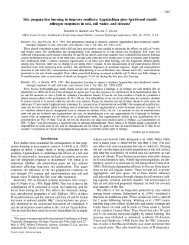biology join - Coweeta LTER - University of Georgia
biology join - Coweeta LTER - University of Georgia
biology join - Coweeta LTER - University of Georgia
Create successful ePaper yourself
Turn your PDF publications into a flip-book with our unique Google optimized e-Paper software.
Articles<br />
present outputs such as the number <strong>of</strong> publications and<br />
presentations given to nonscientific audiences. They also<br />
provide strong evidence <strong>of</strong> uptake such as media coverage,<br />
scientific citations, and Web site visitation. Quantifying the<br />
impact on policy, conservation, and stewardship decisions<br />
remains elusive.<br />
Developing and applying meaningful metrics <strong>of</strong> impact<br />
is a common challenge. Under the auspices <strong>of</strong> the White<br />
House Office <strong>of</strong> Science and Technology Policy, the National<br />
Institutes <strong>of</strong> Health and the NSF are developing metrics <strong>of</strong><br />
impacts for science, called STAR METRICS (Science and<br />
Technology for America’s Reinvestment: Measuring the<br />
Effects <strong>of</strong> Research on Innovation, Competitiveness, and<br />
Science; Lane and Bertuzzi 2011). Several metrics have been<br />
proposed to measure the usefulness <strong>of</strong> scientific knowledge,<br />
many <strong>of</strong> which are applied in these case studies (e.g.,<br />
download or hit rates, media coverage, citations in federal<br />
or state regulations). But in the area <strong>of</strong> broader impacts or<br />
social outcomes, such as those in health, safety, and the environment,<br />
recommendations are under development by an<br />
interagency working group. Impact metrics for science are<br />
an important gap in understanding that should be remedied<br />
by the STAR METRICS program and other science-policy<br />
research efforts.<br />
Conclusions<br />
If science is to aid in the advance toward a more resilient and<br />
sustainable society, we must experiment with more effective<br />
means <strong>of</strong> integrating ecological research and decisionmaking.<br />
As is evidenced by the five case studies presented<br />
here for forest ecosystems and by many other examples,<br />
the <strong>LTER</strong> Network has an important and unique role to<br />
play in addressing the grand challenges in environmental<br />
and sustainability science. The <strong>LTER</strong> Network and associated<br />
research, with its long-term interdisciplinary focus,<br />
its focus on place-based study, its geographic distribution,<br />
its sophisticated information-management systems, and its<br />
public-outreach capabilities, are well suited to boundaryspanning<br />
initiatives that address emerging environmental<br />
issues related to changes in biogeochemistry, biological<br />
diversity, climate change, ecohydrology, infectious disease,<br />
and land use. Policy-relevant synthesis and science communication<br />
should be a focus <strong>of</strong> the <strong>LTER</strong> Network, and these<br />
activities, in turn, would probably promote cross-site and<br />
network-wide coordination <strong>of</strong> matters important to both<br />
science and society. This work could be enhanced by partnerships<br />
with established scientific societies that are dedicated<br />
to similar work. For example, the ESA is advancing a<br />
partnership among academic societies, agencies, and NGOs<br />
“to foster Earth Stewardship by (a) clarifying the science<br />
needs for understanding and shaping trajectories <strong>of</strong> change<br />
at local-to-global scales; (b) communicating the basis for<br />
Earth Stewardship to a broad range <strong>of</strong> audiences, including<br />
natural and social scientists, students, the general public,<br />
policymakers, and other practitioners; and (c) formulating<br />
pragmatic strategies that foster a more sustainable trajectory<br />
<strong>of</strong> planetary change by enhancing ecosystem resilience and<br />
human well-being” (Chapin et al. 2011, p. 45).<br />
Harnessing the power <strong>of</strong> long-term ecological studies<br />
to address the grand challenges in environmental science<br />
will require learning from and building on existing efforts<br />
to better integrate scientific research with societal concerns.<br />
The NSF can facilitate this process by expanding the<br />
bounds <strong>of</strong> informal education to include the engagement <strong>of</strong><br />
decisionmakers and journalists in order to provide the<br />
requisite research and learning needed to develop, test, and<br />
expand these critical experiments at the interface <strong>of</strong> science<br />
and society.<br />
Acknowledgments<br />
The effort and contributions <strong>of</strong> KFL were generously supported<br />
by the Bullard Fellowship program <strong>of</strong> Harvard<br />
<strong>University</strong>’s Harvard Forest and by a grant from Highstead.<br />
This is a contribution <strong>of</strong> the Long Term Ecological Research<br />
Network, which is supported by the US National Science<br />
Foundation and by the US Forest Service. We appreciate<br />
the efforts <strong>of</strong> David R. Foster in shepherding this series <strong>of</strong><br />
articles.<br />
References cited<br />
Berlik MM, Kittredge DB, Foster DR. 2002. The illusion <strong>of</strong> preservation:<br />
A global environmental argument for the local production <strong>of</strong> natural<br />
resources. Journal <strong>of</strong> Biogeography 29: 1557–1568.<br />
Cash DW, Clark WC, Alcock F, Dickson NM, Eckley N, Guston DH,<br />
Jäger J, Mitchell RB. 2003. Knowledge systems for sustainable development.<br />
Proceedings <strong>of</strong> the National Academy <strong>of</strong> Sciences 100:<br />
8086–8091.<br />
Chapin FS III. 2009. Managing ecosystems sustainably: The key role <strong>of</strong><br />
resilience. Pages 29–53 in Chapin FS III, K<strong>of</strong>inas GP, Folke C, eds.<br />
Principles <strong>of</strong> Ecosystem Stewardship: Resilience-Based Natural Resource<br />
Management in a Changing World. Springer.<br />
Chapin FS III, Oswood MW, Van Cleve K, Viereck LA, Verbyla DL, eds.<br />
2006a. Alaska’s Changing Boreal Forest. Oxford <strong>University</strong> Press.<br />
Chapin FS III, Lovecraft AL, Zavaleta ES, Nelson J, Robards MD, K<strong>of</strong>inas<br />
GP, Trainor SF, Peterson GD, Huntington HP, Naylor RL. 2006b. Policy<br />
strategies to address sustainability <strong>of</strong> Alaskan boreal forests in response<br />
to a directionally changing climate. Proceedings <strong>of</strong> the National<br />
Academy <strong>of</strong> Sciences 103: 16637–16643.<br />
Chapin FS III, et al. 2008. Increasing wildfire in Alaska’s boreal forest:<br />
Pathways to potential solutions <strong>of</strong> a wicked problem. BioScience 58:<br />
531–540.<br />
Chapin FS III, Pickett STA, Power ME, Jackson RB, Carter DM, Duke C.<br />
2011. Earth stewardship: A strategy for social-ecological transformation<br />
to reverse planetary degradation. Journal <strong>of</strong> Environmental Studies and<br />
Sciences 1: 44–53.<br />
Cissel JH, Swanson FJ, Weisberg PJ. 1999. Landscape management using<br />
historical fire regimes: Blue River, Oregon. Ecological Applications 9:<br />
1217–1231.<br />
D’Amato AW, Orwig DA, Foster DR. 2006. New estimates <strong>of</strong> Massachusetts<br />
old-growth forests: Useful data for regional conservation and forest<br />
reserve planning. Northeastern Naturalist 13: 495–506.<br />
Driscoll CT, Lawrence GB, Bulger AJ, Butler TJ, Cronan CS, Eagar C,<br />
Lambert KF, Likens GE, Stoddard JL, Weathers KC. 2001. Acidic deposition<br />
in the northeastern United States: Sources and inputs, ecosystem<br />
effects, and management strategies. BioScience 51: 180–198.<br />
Driscoll CT, Cowling EB, Grennfelt P, Galloway JM, Dennis RL. 2010.<br />
Integrated assessment <strong>of</strong> ecosystem effects <strong>of</strong> atmospheric deposition:<br />
Lessons available to be learned. EM Magazine November 2010: 6–13.<br />
364 BioScience • April 2012 / Vol. 62 No. 4 www.biosciencemag.org



